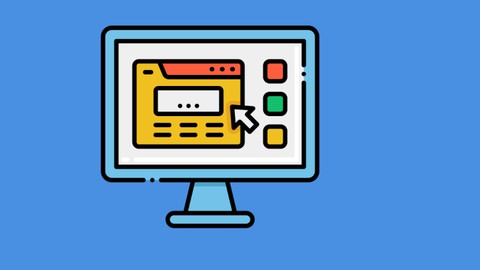
Become A Web Developer: HTML/CSS/JavaScript/Node/Git/GitHub
Become A Web Developer: HTML/CSS/JavaScript/Node/Git/GitHub, available at $19.99, has an average rating of 5, with 113 lectures, based on 1 reviews, and has 17 subscribers.
You will learn about Build structure and content with HTML Apply styling to webpage with CSS Add interaction to webpages and app with JavaScript Build progressive web applications Host your application code remotely on GitHub Deploy your local code remotely using Git Build apps with Node js This course is ideal for individuals who are Beginners to web development It is particularly useful for Beginners to web development.
Enroll now: Become A Web Developer: HTML/CSS/JavaScript/Node/Git/GitHub
Summary
Title: Become A Web Developer: HTML/CSS/JavaScript/Node/Git/GitHub
Price: $19.99
Average Rating: 5
Number of Lectures: 113
Number of Published Lectures: 113
Number of Curriculum Items: 113
Number of Published Curriculum Objects: 113
Original Price: $119.99
Quality Status: approved
Status: Live
What You Will Learn
- Build structure and content with HTML
- Apply styling to webpage with CSS
- Add interaction to webpages and app with JavaScript
- Build progressive web applications
- Host your application code remotely on GitHub
- Deploy your local code remotely using Git
- Build apps with Node js
Who Should Attend
- Beginners to web development
Target Audiences
- Beginners to web development
Web Development is the practice of developing websites and web apps that live on the internet.
All websites use HTML . It’s a fundamental part of every web developer’s toolkit. HTML provides the content that gives web pages structure, by using elements and tags, you can add text, images, videos, forms, and more. Learning HTML basics is an important first step in your web development journey and an essential skill for front- and back-end developers.
CSS, short for Cascading Style Sheets, is a style sheet language used to style websites. Colors, fonts, and page layouts for a site can all be managed using CSS.
JavaScript is a fun and flexible programming language. It’s one of the core technologies of web development and can be used on both the front-end and the back-end. While HTML and CSS are languages that give structure and colors to web pages, JavaScript makes them interactive and come alive.
Node.js is an open-source, cross-platform, back-end JavaScript runtime environment that runs on a JavaScript Engine and executes JavaScript code outside a web browser, which was designed to build scalable network applications.
Git is free and open source software for distributed version control: tracking changes in any set of files, usually used for coordinating work among programmers collaboratively developing source code during software development.
GitHub is an online software development platform used for storing, tracking, and collaborating on software projects
Course Curriculum
Chapter 1: Getting Started
Lecture 1: Introduction
Lecture 2: Core web development languages
Lecture 3: Web development tools
Lecture 4: Text Editors
Lecture 5: Note on text editors
Lecture 6: Installing Visual Studio Code
Lecture 7: Installing Atom
Lecture 8: Installing Sublime Text
Lecture 9: Installing Web Browsers
Lecture 10: What is http
Lecture 11: How the web works
Lecture 12: overview Become A Web Developer: HTML/CSS/JavaScript/Node/Git/GitHub
Chapter 2: Planning a web based project
Lecture 1: Planning your web project
Lecture 2: Creating a mock-up or sketch of your project
Lecture 3: Choosing your assets
Lecture 4: Creating a project directory
Chapter 3: HTML Essentials
Lecture 1: What is HTML
Lecture 2: Anatomy of an HTML Element
Lecture 3: Basic structure of an HTML Document
Lecture 4: Creating a basic HTML Element : Part 1
Lecture 5: Creating a basic HTML Element : Part 2
Lecture 6: Creating a basic HTML Element : Part 3
Lecture 7: HTML Attributes
Lecture 8: Marking Up Text
Lecture 9: Creating Links
Lecture 10: HTML Code Comments
Lecture 11: Viewing HTML Source Code
Chapter 4: CSS Essentials
Lecture 1: What is CSS
Lecture 2: Ways to apply CSS
Lecture 3: Styling multiple properties
Lecture 4: Styling multiple elements
Lecture 5: Modifying CSS
Lecture 6: Basic CSS Selectors
Lecture 7: CSS Comments
Lecture 8: CSS Box Model
Lecture 9: CSS Margin and Padding Property
Lecture 10: Changing background color
Lecture 11: CSS border property
Lecture 12: CSS Positioning
Lecture 13: CSS display property
Lecture 14: CSS font property
Lecture 15: Using google fonts
Chapter 5: JavaScript Essentials
Lecture 1: What is JavaScript
Lecture 2: Where to place JavaScript
Lecture 3: JavaScript Variables
Lecture 4: Variable naming convention
Lecture 5: JavaScript Arrays
Lecture 6: Data Types
Lecture 7: Mixing data types
Lecture 8: JavaScript Operators
Lecture 9: Arithmetic Operators
Lecture 10: Operator Precedence
Lecture 11: String Operators
Lecture 12: Comparison Operators
Lecture 13: Logical Operators
Lecture 14: Conditional Statements
Lecture 15: Functions
Lecture 16: Code Comments
Lecture 17: Linting Tools
Lecture 18: JavaScript Events
Lecture 19: Changing images on a webpage
Lecture 20: Fixing Js Lint warnings: Part 1
Lecture 21: Fixing Js Lint warnings: Part 2
Lecture 22: Adding welcome message to webpage
Chapter 6: Project: Build a web based Calculator
Lecture 1: What we will create
Lecture 2: Overview
Lecture 3: Creating a project directory
Lecture 4: Building the app structure with HTML
Lecture 5: Styling the app with CSS
Lecture 6: Adding functionality with JavaScript
Chapter 7: Project: Build a Todo List Web App
Lecture 1: What we will create
Lecture 2: Overview
Lecture 3: Creating a project directory
Lecture 4: Creating the app structure with HTML
Lecture 5: Style the application with CSS
Lecture 6: Adding functionality with JavaScript: Part 1
Lecture 7: Adding functionality with JavaScript: Part 2
Chapter 8: Project: Build a count down timer
Lecture 1: What we will create
Lecture 2: Overview
Lecture 3: Creating a project directory
Lecture 4: Creating the app structure with HTML
Lecture 5: Styling the app with CSS
Lecture 6: Adding functionality with JavaScript
Chapter 9: Introduction to Progressive Web Applications
Lecture 1: What are progressive web applications
Lecture 2: Features of progressive web apps
Lecture 3: Key components of progressive web apps
Lecture 4: Technologies used to create progressive web apps
Chapter 10: Node js Setup
Lecture 1: What is Node.js
Lecture 2: Installing Nodde.js
Lecture 3: Node.js modules and packages
Instructors
-
247 Learning
An investment in knowledge pays the best interest
Rating Distribution
- 1 stars: 0 votes
- 2 stars: 0 votes
- 3 stars: 0 votes
- 4 stars: 0 votes
- 5 stars: 1 votes
Frequently Asked Questions
How long do I have access to the course materials?
You can view and review the lecture materials indefinitely, like an on-demand channel.
Can I take my courses with me wherever I go?
Definitely! If you have an internet connection, courses on Udemy are available on any device at any time. If you don’t have an internet connection, some instructors also let their students download course lectures. That’s up to the instructor though, so make sure you get on their good side!
You may also like
- Best Software Testing Courses to Learn in December 2024
- Best Big Data Courses to Learn in December 2024
- Best Internet Of Things Courses to Learn in December 2024
- Best Quantum Computing Courses to Learn in December 2024
- Best Cloud Computing Courses to Learn in December 2024
- Best 3d Modeling Courses to Learn in December 2024
- Best Mobile App Development Courses to Learn in December 2024
- Best Graphic Design Courses to Learn in December 2024
- Best Videography Courses to Learn in December 2024
- Best Photography Courses to Learn in December 2024
- Best Language Learning Courses to Learn in December 2024
- Best Product Management Courses to Learn in December 2024
- Best Investing Courses to Learn in December 2024
- Best Personal Finance Courses to Learn in December 2024
- Best Health And Wellness Courses to Learn in December 2024
- Best Chatgpt And Ai Tools Courses to Learn in December 2024
- Best Virtual Reality Courses to Learn in December 2024
- Best Augmented Reality Courses to Learn in December 2024
- Best Blockchain Development Courses to Learn in December 2024
- Best Unity Game Development Courses to Learn in December 2024





















